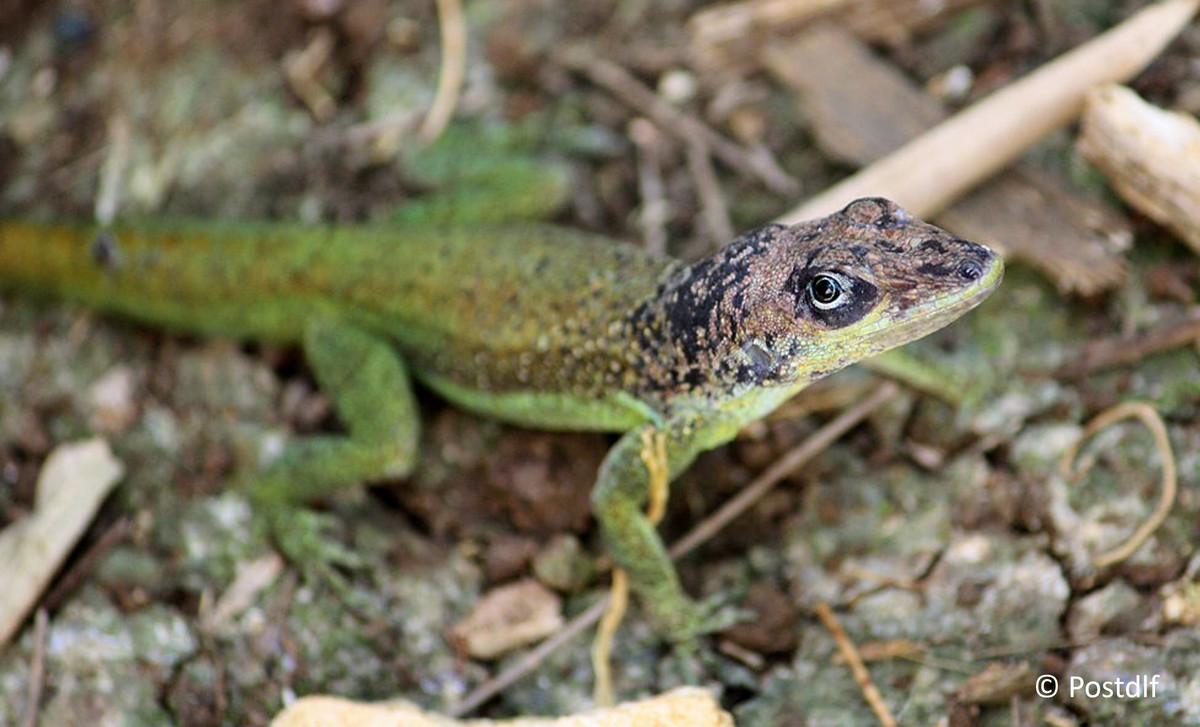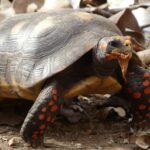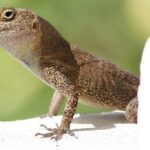
- Common name : Anolis extremus (Garman, 1887)
- Local name : Barbados anole.
- Order : Dactyloidae
- Family : Squamata
Description
Morphology. Medium sized anole. The back if dark green, taking a brown to black colour on the anterior part, sometimes smeared with lighter dots. The colour of the head varies from blue-grey to purple. The ventral side varies from light green to yellow, and the dewlap from orange to yellow.
Standard body size (snout-vent length). males: 46 to 83 mm; females: 42 to 60 mm.
Sexual dimorphism. Only males have a dewlap.
Females are darker than males, and may present dorsal stripes.
Variations. The body colour of the same individual can vary from light to dark, depending on its physiological condition.
Possible confusion with other species. Confusion is possible with the phylogenetically close species, Anolis roquet, native to Martinique.
Distribution
Native. Barbados.
Introduced. Venezuela (Rivas et al., 2012).
Caribbean: Saint Lucia (Gorman, 1976; Giannasi et al., 1997), Bermuda (Losos, 1996), Trinidad (Murphy et al., 1997).
Biology and evology
Habitat. Anolis extremus can cope with a great diversity of natural and anthropized habitats, but seems less present in grasslands.
Diet. Insectivore and frugivore.
Reproduction. The female lays a single egg every one to two weeks. Breeding occurs throughout the year in Barbados, with peak activity during the rainy season (Nummelin 1997).
Behaviour. Similarly to most anole species, males can extend their dewlap in order to defend their territory, or when looking for a breeding partner.
Impact and management of introduced populations
Impact. Gorman (1976) suggested that Anolis extremus may have displaced the native species A. luciae in some urban and peri-urban areas of Castries in Saint Lucia. Williams and colleagues (2019) pointed out that A. extremus seems to prevail only in these urban and disturbed areas, but recent observations in eastern and southern parts of the island suggests a potentially broader dispersion.
Giannasi and colleagues (1997) also noted the absence of hybridisation, sometimes suggested, between A. extremus and A. luciae.
Management. To date, no targeted control measures have been established in the different regions where the species has been introduced.
Bibliographie
- Giannasi, N., Thorpe, R. S., & Malhotra, A. (1997). Introductions of anolis species to the islan of St. Lucia, West Indies: testing for hybrids using multivariate morphometrics. Journal of Herpetology, 31, 586–589.
- Gorman, G. C. (1976). Observations on the distribution of Anolis extremus (Sauria: Iguanidae) on St. Lucia, West Indies: a “colonizing” species. Herpetologica, 32, 184–188.
- Losos, J. B. (1996). Dynamics of range expansion by three introduced species of anolis lizards on Bermuda. Journal of Herpetology, 30, 204–210.
- Murphy, J. C., Downie, J. R., Smith, J. M., Livingstone, S. M., Mohammed, R. S., Lehtinen, R. M., … Jowers, M. J. (1997). A field guide to the Amphibians & Reptiles of Trinidad & Tobago (R. J. Auguste, ed.). Malabar, Florida: Krieger Publishing Compagny.
- Nummelin, M. (1997). Seasonal occurrence of juvenile Anolis extremus Garman in forest patches in Barbados. Journal of the Barbados Museum and Historical Society, 43, 24–31.
- Rivas, G. A., Molina, C. R., Ugueto, G. N., Barros, T. R., Barrio-Amorós, C. L., & Kok, P. J. R. (2012). Reptiles of Venezuela: An updated and commented checklist. In Zootaxa, 64.
- Williams, R. J., Morton, M. N., Daltry, J. C., & Toussaint, A. (2019). The distribution of non-native Anolis lizards on Saint Lucia, Lesser Antilles. Caribbean Journal of Science, 49, 281.





